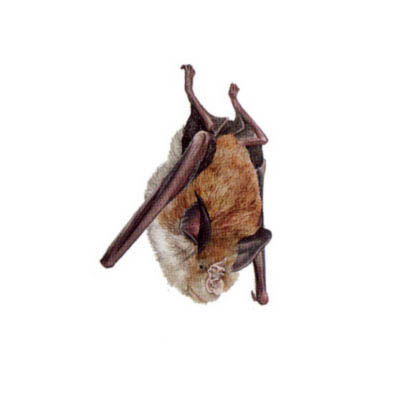Mehely's horseshoe bat

Rhinolophus mehelyi (Matschie, 1901)
Rhinolophidae
Vulnerable
| Other names | |
|---|---|
| Catalan | Ferradura mitjana |
| Spanish | Murciélago mediano de herradura |
| English | Mehely's horseshoe bat |
| French | Rhinolophe de Mehely |
| Basque | Mehely ferra-saguzar |
| Galician | Morcego de ferradura mediano |
Description
A medium-sized rhinolophid bat, similar to the Mediterranean horseshoe bat (Rhinolophus euryale), with a body length ranging from 49-64 mm, a wingspan of 300 to 340 mm, a forearm oscillating between 47 and 55 mm, a weight of 10 to 18 g, and a tail of 23 to 32 mm. The fur is distinctly different from other horseshoe bats in Europe, featuring a reddish-orange colour on the back and orange-beige on the belly. The ears and wing membranes have a grayish-brown colour, similar to other species of horseshoe bats. The nose leaf is pointed and slightly curved. The size and shape of the nose leaf are used to distinguish it from other species in the same genus. The ears are relatively long and mobile, measuring between 18-23 mm.
It is easily distinguished from the greater horseshoe bat (Rhinolophus ferrumequinum) and the lesser horseshoe bat (Rhinolophus hipposideros) due to its intermediate size and distinctive nose leaf, where the connective process is much more prominent than the saddle. It is also differentiated from other medium-sized horseshoe bats by characteristics of the nose leaf and wing.
Distribution
This species is limited to Mediterranean region, with a strongly fragmented distribution. It can be found in North Africa (Morocco, Algeria, Tunisia, and Egypt), Southern Europe (southern Iberian Peninsula, some locations in Italy, possibly in France, and in some Balkan countries). Former populations on the coasts of Croatia and the Adriatic have not been confirmed. Isolated occurrences of this species can also be found in Asia Minor, Turkey, the Caucasus region, Iran, and Afghanistan.
Roosts and phenology
This species almost exclusively roosts in natural underground shelters, both in summer and winter, although solitary individuals have been found in human buildings. Maternity colonies typically consist of about 20-200 individuals, rarely reaching 500 animals. In northern Bulgaria, there are records of a breeding colony of around 5,000 individuals, which has drastically reduced in size. These colonies are usually mixed with Mediterranean horseshoe bats (Rhinolophus euryale) and other cave-dwelling species, typically in warm underground shelters. Females give birth from June to July, and juveniles start flying and hunting after three weeks of being born. This species reaches sexual maturity at the age of two.
It is considered a non-migratory species, although there have been recoveries of individuals at distances of up to 90 km.
Habitat and diet
Although it can be found in various habitats, it is common to encounter it in open habitats such as scrublands, meadows, crops, pastures, and also in sparse Mediterranean forest habitats like evergreen oaks, olive groves, or plantations. This species is scarce in continental or Atlantic climates. It is usually found at low altitudes, below 700 meters.
Its diet consists of about 90% moths, although other prey includes crane flies, beetles, and some lacewings. It tends to hunt in open habitats such as meadows and crops, flying above herbaceous cover or in shrubby margins at a maximum height of 6 meters. The foraging area is typically around 3-8 km away from the roost. Although it hunts in the air, when prey is scarce, pregnant females may hunt by hovering from a branch or shrub, with agile and maneuverable flights lasting less than 30 seconds.
Echolocation
Similar to other rhinolophid species, the echolocation of R. mehelyi features uniform calls with a peak frequency around 105 kHz, ranging between 104-112 kHz. The duration of their calls can vary between 20 and 30 ms. Although it is easily identifiable acoustically in some areas, when it coexists with the lesser horseshoe bat (Rhinolophus hipposideros) or the Mediterranean horseshoe bat (Rhinolophus euryale), its calls may overlap with these species in the upper and lower limits, respectively. Therefore, whenever it is in sympatry with either of these two species, it falls within the sonotypes Rhinolophus hipposideros/R. mehelyi or Rhinolophus euryale/R. mehelyi, respectively.
Status
According to the IUCN Red List, this species is considered Vulnerable, with a negative population trend. It is protected by national laws, such as the Eurobats Agreement, the Bern Convention, and the European Habitats and Species Directive. It is the rarest European rhinolophid species, having disappeared from many areas of its historical distribution. This species is particularly sensitive to the loss of insect rich pastures and crops and disturbance in its roosts. When coupled with the loss of favourable habitats, it makes the future of this species in Europe uncertain.